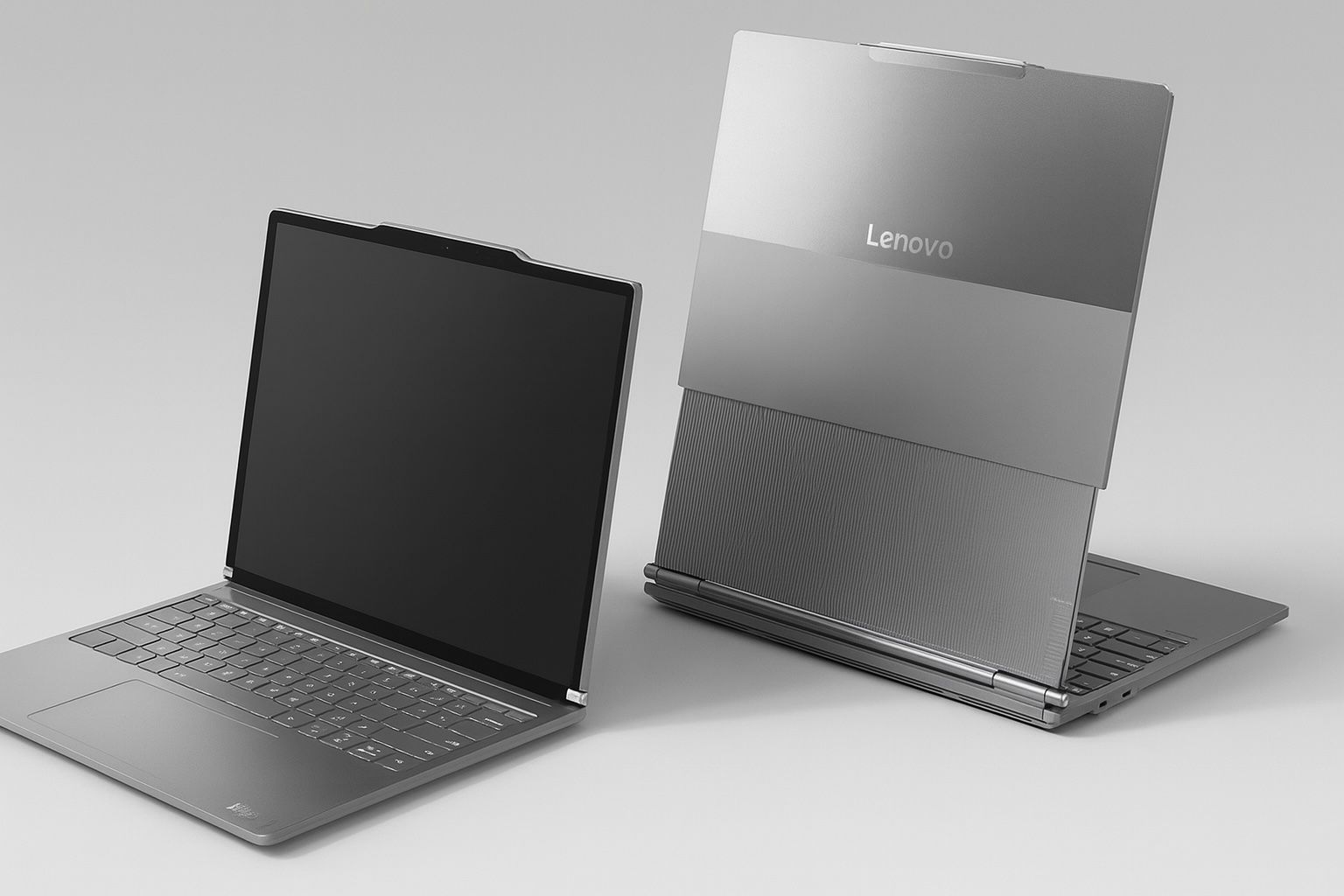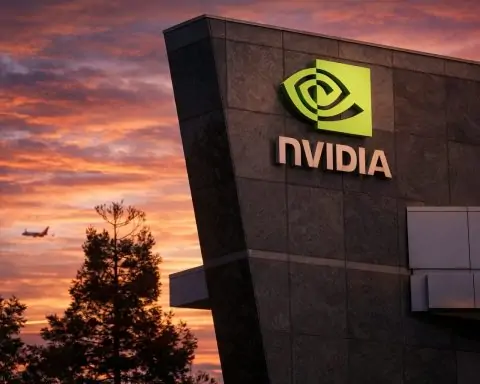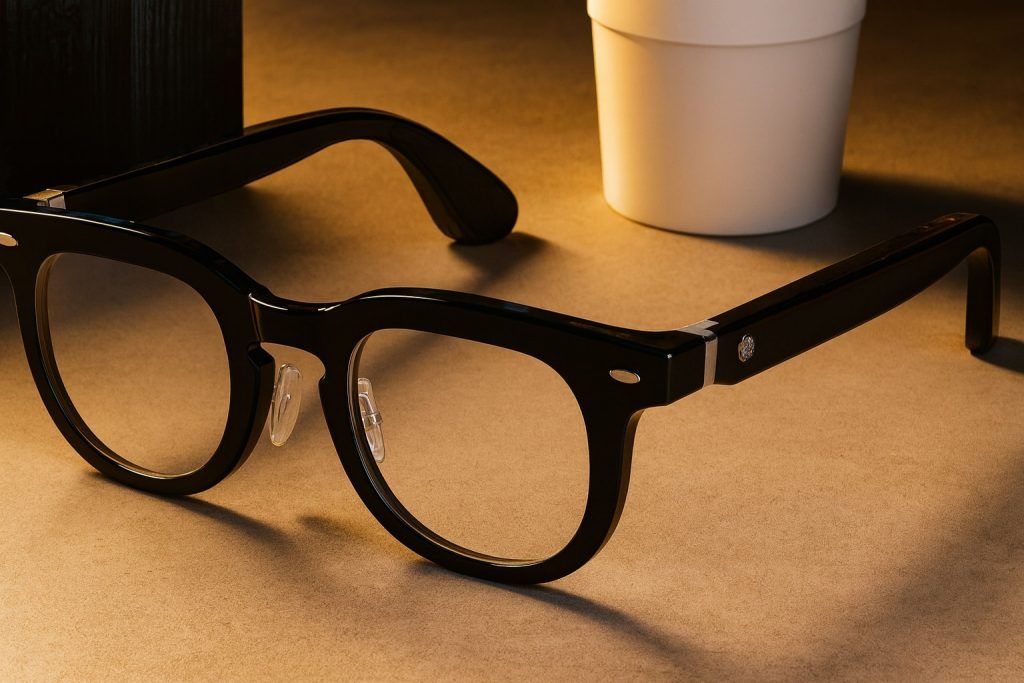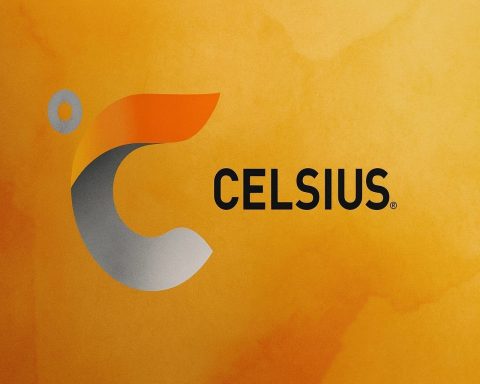Key Facts
- Expanding OLED Screen:World’s first rollable-screen laptop – a 14-inch OLED (2000×1600, 5:4 ratio) that vertically extends to 16.7 inches (2000×2350, 8:9 ratio) at the press of a button [1] [2], offering nearly 50% more screen space for multitasking. The flexible 120Hz panel is bright (400 nits), vivid (100% DCI-P3), and durable – rated for 20,000 rolls and 30,000 hinge cycles [3]. No touch support on this display, but its motorized “tallboy” transformation is mesmerizing and genuinely useful [4] [5].
- Unique Dual-Mode Design: In standard mode it’s a compact 14″ laptop; in “extended” mode it resembles two stacked 12.4″ screens (16:9 each) [6] – perfect for viewing tall documents, coding, or stacking windows without an external monitor. Lenovo’s ThinkBook Workspace software enables split-screen widgets and a “virtual display” mode for sharing just part of the screen in meetings [7] [8]. Reviewers note the tall aspect is great for productivity and even reduces neck strain by bringing the webcam to eye level [9] [10].
- High-End Specs: Powered by up to Intel Core Ultra 7 (14-core “Lunar Lake” CPU) with 32GB LPDDR5X RAM and 1TB PCIe 4.0 SSD [11] [12]. It uses Intel’s integrated Arc graphics (no discrete GPU) [13] – good enough for light gaming and creative work with AI boosts. 66 Wh battery and aggressive power settings yield around 8–10 hours of real-world use on default mode [14] [15]. However, running the 120Hz OLED at full tilt can shorten battery life (reviewers saw ~7–9 hours) [16]. Cooling is quiet and the chassis stayed cool under typical loads [17].
- Premium Build, Few Ports: Sleek aluminum design (19.9 mm thick) weighing ~1.7 kg (3.7 lb) [18] – impressive given the motor mechanism. Ports are minimal: just two Thunderbolt 4 USB-C and a headphone jack [19] [20]. No USB-A or HDMI, meaning dongles are a must for peripherals. There’s a fingerprint reader (in the power button) and IR webcam for Windows Hello login [21] [22]. The 5MP webcam is higher-res than typical and centered high up (thanks to the tall screen), which gives a more flattering, eye-level angle for video calls [23].
- Innovative ThinkBook Lineage: The ThinkBook Plus series is Lenovo’s playground for dual-screen innovation. Previous gens experimented with E-Ink lid displays and secondary LCDs (Gen 2 had an E-Ink cover, Gen 3 had an 8″ keyboard deck screen, Gen 4 “Twist” featured a swiveling OLED/E-Ink combo) [24]. The Gen 6 Rollable takes a new approach: a single display that “unrolls” to expand, offering a novel solution to screen real estate without the bulk of a second panel [25]. It was first shown as a wild concept at CES 2023; by CES 2025 Lenovo turned it into a real product you can actually buy [26] [27].
- Price & Availability:Starts around $3,299–$3,499 in the U.S. [28] [29] – a luxury price on par with high-end workstations. It’s slated for release in June 2025 in North America [30]. European pricing is similarly steep (e.g. ~£3,700 in the UK with VAT, or ~€3,300) [31] [32]. This premium cost reflects the cutting-edge tech and fully loaded specs (32GB RAM/1TB are standard). It will be available through Lenovo and select business channels; limited early stock and a “Temporarily Unavailable” note on Lenovo’s site as of August suggests a gradual rollout [33].
Meet the Laptop That Grows: Design & Display Revolution
The Lenovo ThinkBook Plus Gen 6 Rollable looks like a normal sleek 14-inch laptop—until you hit the magic button. With a whir of tiny motors, the OLED screen glides upward inside the lid, stretching the display from 14″ to 16.7″ tall [34]. In an era of foldables and dual-screens, this rollable design is truly one-of-a-kind. “Push a button and get more screen,” writes The Verge, calling it “one of the coolest and most futuristic-looking laptops I’ve ever used.” [35] [36] The extended screen is like having a portable dual-monitor setup stacked vertically, without carrying any extra devices. It’s a productivity dream for coders, writers, and anyone who scrolls through long documents or feeds. No more constant scrolling – you see 50% more content at once.
This tall aspect ratio also means better ergonomics. With the screen elevated, you’re not hunching over – the top of the display sits near eye-level. Reviewers noted it “helped relieve a bit of neck pain” during long work sessions [37]. And in video calls, the high webcam placement keeps your face centered and at eye height, making for more natural meetings [38] [39]. It’s a clever benefit of the otherwise flashy design. Lenovo even pitches the vertical screen as a posture improvement for professionals working hours on laptops [40].
Of course, the star is that Flexible OLED panel. When unrolled to full size, it has a somewhat unusual 8:9 aspect ratio – basically twice as tall as it is wide. In practice, it’s like two standard 13″ laptop screens stacked [41]. The OLED technology delivers punchy colors, deep contrast, and fast 120Hz refresh for smooth visuals [42]. At 400 nits brightness and 100% DCI-P3 gamut, it’s excellent for both spreadsheets and creative work [43]. The trade-off of using a flexible plastic OLED is a few faint ripples/creases near the bottom (where the screen curls when retracted). However, multiple reviewers noted you “have to look from just the right angle” or on a white background to notice any crease – in normal use it’s minor [44] [45]. The mechanism takes ~8–10 seconds to fully extend or retract the display [46] [47], and emits a soft motor whirring (comparable to a quiet fan). It’s an attention-grabber in meeting rooms and coffee shops for sure – as WIRED quipped, “nothing will catch the attention of every other person in a coffee shop like rolling up with one of these babies.” [48]
How sturdy is it? Lenovo stresses they didn’t build a fragile concept toy – the chassis and hinge are solid aluminum, and the screen mechanism is tested for tens of thousands of cycles [49]. In demos, Lenovo reps casually tossed the prototype in a backpack and even closed the lid with the screen still extended (creating a weird “overbite” gap) – and all was fine [50]. Early reviewers echoed that it feels robust. “In fact, it feels more reliable than my foldable phone… the motor unrolls it nicely every time,” noted PCWorld [51]. The laptop meets MIL-STD 810H durability standards (for shocks, vibration, etc.), so it’s built to handle travel. Still, with any moving display, there’s a lingering concern about long-term wear and potential repair costs (Lenovo hasn’t revealed what a replacement screen would cost) [52] [53]. But as a first-gen of its kind, it’s remarkably well-engineered – a testament to Lenovo’s willingness to “turn ambitious concepts into fully functional products” [54] [55].
Dual-Screen Alternatives?
It’s worth noting how different Lenovo’s approach is from other attempts to give laptop users more screen space. Prior ThinkBook Plus models tried E-Ink secondary screens (useful for reading or notes) and even an 8″ color LCD next to the keyboard in the Gen 3 model [56]. Other brands have gone with dual full displays – like the Asus ZenBook Duo series or Lenovo’s own Yoga Book 9i – but those make for very wide, power-hungry devices, essentially a laptop with a second screen where the keyboard usually goes [57]. There are also foldable PCs (Asus ZenBook Fold, ThinkPad X1 Fold) that open into a big tablet, but they tend to be cumbersome “Franken-laptops” with kickstands or keyboard attachments [58]. The ThinkBook Plus Gen 6’s rollable screen is arguably more elegant: you hit a button and the laptop itself grows taller. No extra pieces to carry or set up – it’s still one integrated device [59]. This lets you casually pop it open on your lap or a cafe table and gain a ton of vertical workspace on the fly, then pack it up like a normal 14″ notebook. It’s a bold new solution to the eternal desire for more screen real estate in a portable form factor.
Under the Hood: Performance, Specs & Features
Despite the futuristic exterior, the ThinkBook Plus Gen 6 comes with all the trappings of a modern high-end laptop. It runs on Intel’s latest Core Ultra processor (13th/14th-gen hybrid) – specifically up to a Core Ultra 7 258V chip [60] [61]. This is an 8-core/16-thread processor (with additional efficiency cores) optimized for AI tasks and efficiency, part of Intel’s new “Ultra” series. In benchmarks, its CPU performance is on par with other premium ultrabooks using the same chip [62]. It’s plenty fast for everyday productivity, heavy web use, and moderate content creation. In fact, thanks to the high-speed 32GB LPDDR5X memory, multitasking is a breeze – dozens of Chrome tabs, spreadsheets, and even some light 1080p video editing won’t faze it. The integrated Intel Arc graphics (Xe-based) are more potent than previous gen Intel GPUs; you can even play lighter games like Fortnite at decent frame rates (medium settings with upscaling) [63] [64]. This GPU also helps accelerate AI features and creative apps (it’s DirectX 12 and OpenCL capable). Still, this is not a gaming or 3D rendering laptop – there’s no discrete NVIDIA/AMD GPU option, likely due to space and heat constraints. For most business and creative professionals, the integrated graphics suffices, but something like CAD or heavy 4K video work isn’t the ThinkBook’s forte.
Thermals and noise: Impressively, the device stays quiet and relatively cool. The Verge reported “I rarely heard its fan spin up or felt it heat up” during a full work day of mixed tasks [65]. Lenovo’s design seems to handle the OLED and CPU heat well, possibly because the chassis is a bit thicker (just under 20 mm) – giving the cooling system room to breathe. The bottom “engine hub” houses the components and likely some heat pipes, and the hinge area (where the rolled screen rests) may also allow airflow. Even under extended load (e.g. a long video encode), reviewers found it performs about on par with other laptops with this CPU, throttling only slightly in multi-core sustained tasks [66] [67]. The upside of the efficient Intel chip and aggressive default settings: great battery life for its class. Lenovo tuned the laptop out-of-the-box for battery longevity – the OLED ships in 60Hz mode with HDR off and the system on “best efficiency” mode [68]. With those, some testers managed 9–10 hours on Wi-Fi productivity [69]. In a video rundown test (with more demanding settings), WIRED got about 10 hours of local 1080p playback [70]. In heavy real-world use (brightness up, 120Hz on, lots of multitasking) expect closer to 7–8 hours before reaching for the charger [71] [72]. That’s not class-leading (some ultrabooks hit 12+ hours), but decent given the large OLED. And crucially, Lenovo built a smart fail-safe: if your battery falls below 5%, the laptop will automatically roll the screen down (with a 30-second warning) so you’re not stuck unable to close it when power dies [73]. A thoughtful touch for this new form factor.
On the memory and storage front, the Gen 6 Rollable is maxed out – every configuration comes with dual-channel 32GB RAM (soldered LPDDR5x) and up to a 1TB NVMe SSD [74]. That means no configurable lower-end model; Lenovo is treating it as a halo flagship device. In fact, WIRED noted there’s “just one configuration available, and it’s a stacked model… 32GB RAM/1TB” which partly explains the high price [75]. The upside is you won’t feel the need to upgrade internals for years. The downside: you’re paying for high specs even if your use case wouldn’t have required 32GB memory.
Keyboard & trackpad: Lenovo didn’t skimp on the input devices – a relief, since a $3k+ gimmicky laptop must still type well. The edge-to-edge keyboard has full-size keys with 1.5 mm travel, and reviewers absolutely love it [76]. It’s not a ThinkPad, but “the keys are snappy and precise” with a comfortable tactile feedback [77]. The layout includes the handy “Extend Screen” function key, and interestingly, no dedicated PgUp/PgDn or media keys (likely due to that function row button for the mechanism). The haptic touchpad is equally praised – it’s a large glass-like surface that doesn’t physically click but uses haptic motors to simulate clicks, similar to MacBooks or Surface Laptop Studio’s pad [78]. You can click anywhere and adjust feedback. WIRED called it “great… like the ones on Surface Laptop or MacBook Pro” [79]. All in all, Lenovo ensured the fundamentals (typing, navigating, audio, webcam) are flagship-grade, not just the display. The Harman/Kardon stereo speakers (2×2W) support Dolby Atmos and are surprisingly strong for a thin business laptop – “unusually great” with balanced sound and even some bass, according to PCWorld’s tests [80] [81]. And the 5MP webcam + dual mics make for clear Zoom calls; plus you get Windows Hello IR for quick logins [82] [83].
One obvious compromise of the sleek design: limited ports. All physical connectors sit on the left side: just 2 Thunderbolt 4 USB-C ports and a 3.5mm headphone jack [84] [85]. The right side only has the power button (with built-in fingerprint reader) [86]. This means no standard USB-A, no HDMI, no SD card slot – a sparse selection even for a 14″ machine. For a device partly aimed at creatives and execs, some will miss those ports. Lenovo’s rationale is that Windows treats the extended screen portion as a “second display” in software [87], so driving another external monitor could be tricky; indeed, they warn it’s “not designed to be used with external monitors” via HDMI [88]. Still, you can connect docks or adapters via Thunderbolt as needed (DisplayPort Alt-mode is supported). Expect to live the dongle life for projectors or USB drives – “you’ll need a hub”, as one review flatly put it [89]. In a bit of irony, the ThinkBook Plus’s rollable screen saves you from carrying a portable second monitor, but its lack of ports means you might carry a USB-C hub instead [90] [91]. It’s a trade-off many modern ultrabooks make, so not a huge shock, but definitely a consideration for pro users.
Software & AI: The laptop comes with Windows 11 Pro and is branded as an “AI PC” or Copilot+ PC by Lenovo [92]. This means it meets Microsoft’s requirements for AI features like Windows Studio Effects (background blur, eye contact adjustments on the webcam) [93], and it’s ready for Windows Copilot integration. Lenovo includes its own Lenovo AI Now assistant – a local AI that can help organize files, automate tasks, and function offline using generative AI models [94]. It’s built on a local Llama 3-based model, aiming for privacy (processing data on-device) [95]. In use, these AI features might suggest replies to emails, automate meeting notes, or optimize performance settings in real-time. There’s also a “Cocreator” feature in collaboration with apps like Paint (as mentioned in the press release) to leverage AI in creative workflows [96]. While these additions are interesting, the core experience is still standard Windows 11 – just augmented with some smart helpers. One noteworthy software quirk: Because the extended screen acts like a second monitor in Windows, you can’t simply drag a window to the “bottom” part and have it snap. Lenovo’s Workspace app is used to pin content to that lower screen area [97]. This is a stopgap until Microsoft possibly adds native support for rollable/flexible displays in the OS. It’s not a deal-breaker, but reviewers did find Lenovo’s multitasking software a bit clunky, saying it “isn’t great” and wastes some space with extra title bars [98] [99]. Fortunately, normal Windows window-snapping does work across the tall display as if it were one big monitor – e.g. Win+Up will snap a window to the top half and another to the bottom. So you can effectively split-screen two apps vertically with ease [100] [101].
How It Stacks Up to Competition
The ThinkBook Plus Gen 6 Rollable lives in the premium tier of business/creative laptops. Its closest competitors aren’t other rollable PCs (there are none yet!), but rather flagship ultrabooks and 2-in-1s that professionals might consider for advanced productivity. Below we compare key specs of the ThinkBook Plus Gen 6 against some top rivals: HP Spectre x360 14 (2024), Dell XPS 13 Plus, and Microsoft Surface Laptop Studio 2.
| Laptop | Lenovo ThinkBook Plus Gen 6 (Rollable) | HP Spectre x360 14 (2024) (Convertible) | Dell XPS 13 Plus (2023) (Ultrabook) | Microsoft Surface Laptop Studio 2 (2023) |
|---|---|---|---|---|
| Starting Price (USD) | ~$3,299 (expected) [102] [103] | ~$1,540 (Core i5 model) [104] | ~$1,300 (base model) [105] | ~$1,999.99 (base i7 model) [106] |
| Display | Rollable 14″ OLED (5:4) expanding to 16.7″ (8:9); 2000×1600 → 2000×2350; 120Hz, non-touch [107] | 13.5″ 3:2 OLED (3000×2000); 60–120Hz; Touchscreen (360° hinge, pen support) | 13.4″ 16:10 OLED (3456×2160) or FHD+; 60Hz; Touchscreen (clamshell design) [108] | 14.4″ 3:2 LCD (2400×1600); 120Hz; Touchscreen (pull-forward easel hinge, pen support) [109] [110] |
| CPU & Memory | Intel Core Ultra 7 (Series-2, 14-core “Lunar Lake” 258V); 32GB LPDDR5X RAM (dual-channel) [111] [112] | Intel Core Ultra 7 155H (15-core, 28W) or Core i5; up to 32GB LPDDR5X [113] | Intel Core i7-1360P (12-core, 28W) or i5; up to 32GB LPDDR5 | Intel Core i7-13700H (14-core, 45W); up to 64GB LPDDR5X [114] |
| Graphics | Intel Arc integrated GPU (Xe 96EU, AI-boosted) [115] | Intel Iris Xe integrated (or Intel Arc for Ultra CPUs); no discrete GPU | Intel Iris Xe integrated; no discrete GPU | NVIDIA GeForce RTX 4050/4060 (6–8GB) or RTX 2000 Ada; Intel Iris Xe in base [116] [117] |
| Storage | 1TB PCIe 4.0 SSD (M.2 2242) [118] (no HDD/SD slot) | up to 2TB NVMe SSD (PCIe 4.0) | up to 2TB NVMe SSD (PCIe 4.0) | 512GB–1TB SSD (removable) [119] |
| Battery & Power | 66 Whr battery; ~8–10 hr real use; 65W USB-C GaN charger [120] [121] | 66 Whr battery (est. 10+ hr); 65W USB-C charging | 55 Whr battery (mediocre ~7–8 hr in reviews); 60W USB-C charging | 58 Whr battery (~7 hr in use [122]); 127W proprietary charger |
| Dimensions (mm) | 303 × 230 × 19.9 (thickness) [123] | ~298 × 221 × 17 (tablet mode ~17mm thin) | 295 × 199 × 15 (extremely thin design) | 323 × 230 × 18–22 (wedge shape) [124] |
| Weight | ~1.69 kg (3.72 lb) [125] [126] | ~1.36 kg (3.0 lb) | ~1.23 kg (2.71 lb) [127] | ~1.9 kg (4.18 lb) in top config [128] [129] |
| Notable Features | Rollable OLED screen expands ~50% vertically; AI Copilot+ features; premium haptic touchpad; only TB4 ports (no USB-A) [130] | 2-in-1 convertible: flips 360° into tablet; comes with stylus; sleek gem-cut aluminum design; IR webcam + fingerprint; Thunderbolt 4 + USB-A + microSD (good port mix) | Minimalist design: edge-to-edge backlit keyboard and “invisible” haptic touch bar keys; no headphone jack (USB-C only); premium aluminum build (XPS line) | Creative workstation: unique pull-forward easel hinge for drawing mode; high-power CPU/GPU for content creation; expansive port selection (TB4, USB-A, microSD, etc.); precision haptic touchpad; supports Slim Pen 2 stylus |
In summary, the ThinkBook Plus Gen 6 is in a league of its own due to that rollable display. Traditional premium laptops like the Spectre x360, XPS 13 Plus, or Surface Studio 2 each have their advantages – the HP offers a convertible tablet mode and OLED in a more affordable package, the Dell is an ultra-portable style statement, and the Surface Studio 2 packs a discrete GPU and a versatile easel hinge for artists. But none can match the sheer novelty and multitasking benefit of a laptop that grows taller on command. The closest analog might be using an external portrait monitor above a laptop – except here it’s built-in and always with you. As The Verge points out, “$3,300 can get you a lot of other excellent laptops… but none of them have this extending display.” [131] It’s one of the only ways to have a large vertical workspace in a machine that still slips into a normal laptop bag. For executives, content creators, or developers who live in multiple windows, that could be a game-changer.
Of course, if your work is more GPU-intensive (3D modeling, heavy video editing), a laptop like the Surface Laptop Studio 2 or a Dell XPS 15 might serve better with their beefier graphics. And if you just need a solid ultra-portable, the ThinkBook’s weight and price might be overkill – you could get three very good $1,000 laptops for the cost of one Gen 6 Rollable [132]. Lenovo is clearly targeting a niche: those willing to pay a premium for cutting-edge innovation and productivity perks. For that audience, the usual suspects (XPS, Spectre, Surface, MacBook, etc.) feel almost ordinary by comparison.
Early Reviews & Public Reception
The ThinkBook Plus Gen 6 Rollable has generated significant buzz in the tech world. At CES 2025, it was widely hailed as a showstopper. “I can confidently say Lenovo’s ThinkBook Plus Gen 6 stole the show for me at CES,” wrote The Verge’s Antonio G. Di Benedetto, describing how a “dumb smile” formed as he watched the screen extend for the first time [133]. That mix of wonder and skepticism has carried into real-world reviews now that units are in reviewers’ hands.
WIRED (7/10) was impressed by how practical the roll-out screen proved to be: “This laptop can magically expand its screen … Turns out, that’s a lot more useful than you’d expect.” [134] In daily use, reviewer Luke Larsen found himself keeping it in tall mode almost all the time, enjoying the ability to “throw a video, social feed, or Slack up top with my writing window down below” without a hitch [135] [136]. He praised the build quality – “ergonomically sound” – and noted the webcam placement and tall aspect improve videoconferencing. WIRED’s pros included the fun factor, great OLED quality, and precise keyboard/haptic touchpad [137]. Cons were that it’s “not exactly subtle” (everyone notices the transforming laptop), the screen has minor crease artifacts, limited ports, and battery life was just okay [138] [139]. They concluded that once the wow factor wears off, you’re still left with a premium and immensely useful laptop – “that’s what separates gimmicks from innovation.” [140]
The Verge (Score: 7/10) gave perhaps the most glowing endorsement, calling it “the coolest computer I’ve used all year” [141] and stating “it’s actually good. Not just good, but very good. I still can’t believe it.” [142] The review highlighted how the tall screen improved productivity and even comfort, echoing that video calls are more pleasant at eye-level and long scrolling sessions are easier on the neck [143] [144]. They applauded the “top-tier” keyboard and trackpad and even lauded its performance and battery life as “great” for its class [145]. (Their tests achieved about 9 hours on a charge in mixed use, which they considered strong given the OLED screen [146].) The Verge’s criticisms aligned on price and portability: at 3.7 lbs, it’s “heavy for its size” and the screen assembly adds some heft and limits how far back the lid can tilt [147]. They also noted Lenovo’s custom window management software felt clunky, and observed that the plastic OLED panel can wobble and creak slightly when extended (since it’s thinner and not touch-enabled) [148]. But overall, The Verge sees it as both “a genuinely cool idea, and a great laptop.” The reviewer mused that it could remain a niche “unicorn” product for now, but expressed hope this “might be the start of a rolling-screen revolution” in PCs [149].
Other outlets echo these sentiments. PCWorld termed it “a sci-fi laptop you can buy” and complimented the solid feel of the mechanism and the surprisingly good speakers and webcam for business use [150] [151]. Tom’s Guide and Tom’s Hardware did hands-on previews at CES, both essentially marveling at the “magical” expanding screen and noting the steep price tag. On social media and forums, the public reception mixes awe and pragmatism – many commenters love the concept (“take my money!” Reddit threads proclaim) while others joke that they’d “wait for Gen 2 or 3 when it’s cheaper.” It’s the classic early-adopter dilemma. Tech enthusiasts applaud Lenovo’s courage to commercialize this, noting that Lenovo has a track record of pushing the envelope (from the keyboard-with-screen Yoga Book to the ThinkPad X1 Fold and dual-screen ThinkBook Plus Gen 3). There is also an appreciation that Lenovo targeted productivity rather than pure entertainment with the rollable – using it for spreadsheets and coding makes more sense than, say, a rollable TV for Netflix (though it’s great for that too).
Even Lenovo’s competitors are watching. Samsung Display is actually the supplier of the flexible OLED panel inside [152], and they have shown similar prototypes – it wouldn’t be surprising if others like Dell or HP explore rollable concepts if the Gen 6 gets traction. For now, the ThinkBook Plus Gen 6 stands alone, earning a reputation as a bold, quirky, but legitimately useful device. As one review succinctly put it: “Buy this thing, and you’ll want to show off the transformation just to see the look on people’s faces. And once that excitement wears off, you’ll still have a laptop that is both premium and immensely useful.” [153] [154]
Pricing, Availability & Market Outlook
The ThinkBook Plus Gen 6 Rollable is expected to hit the market in summer 2025, with Lenovo citing a June launch for the US [155]. However, initial availability may be limited – by late August 2025, Lenovo’s US website listed it as “Coming Soon/Temporarily Unavailable,” suggesting a slight delay or sell-out of early stock [156]. Price-wise, it’s firmly in ultra-premium territory. Lenovo’s announcement pegged it at a starting price of $3,499 in the US [157], though a later listing and reviews indicate around $3,299 base price (perhaps Lenovo adjusted it slightly) [158]. Either way, over $3k puts it out of reach for most consumers. This is a device aimed at professionals, enterprises, or well-heeled tech enthusiasts who value the unique capabilities. For context, a fully-loaded Dell XPS 13 Plus or HP Spectre might max out around $2k, and even a 14″ MacBook Pro with M3 Pro (with excellent performance) is about $2,000–$2,500. The ThinkBook Rollable, in effect, charges a ~$1,000 innovation premium for that expanding screen and cutting-edge design.
In Europe, prices are similarly high: the Surface Laptop Studio 2’s UK launch price was £2,069 (about $2,570) for comparison, and the ThinkBook Plus Gen 6 is likely around £3,300–£3,700 in the UK (inc. VAT) based on reseller info [159]. A UK tech leasing firm cites £3,700 incl. VAT as a starting point [160]. The Guardian reported the Surface Studio 2 at €2,239/$1999, but the ThinkBook Rollable hasn’t had an official Euro price publicized; expect roughly €3,300–€3,500 in Euro-zone countries if/when it launches there. It’s likely to appear in limited quantities in EMEA and Asia-Pacific markets where Lenovo has enterprise customers. In China (Lenovo’s home turf), such experimental models often debut via Lenovo’s online store – for instance, the previous ThinkBook Plus Gen 5 (Twist) was around CNY ¥15,999 (~$2,250) in China [161]. The Rollable Gen 6 could easily top ¥ twenty-something thousand there given its higher tech.
Availability will likely focus on direct sales and enterprise channels. This isn’t a Best Buy shelf product. Lenovo’s press materials position it as a tool for “mobile professionals, business travelers, and productivity-focused workers” who need something extra [162]. We might see Lenovo offer it as part of bespoke orders or limited releases (much like how ThinkPad X1 Fold was sold in limited runs initially). If you’re eager to get one, the safest bet is ordering straight from Lenovo’s website or through a Lenovo business partner once it officially goes on sale.
For those with sticker shock, Lenovo points out options like leasing or as-a-service plans for businesses to acquire these. (The HardSoft UK blog even pitches that leasing can make the £3700 price easier to swallow over time [163] [164].) It underscores that this is largely a proof-of-concept turned halo product – not intended to be a mass-market bestseller. Lenovo likely expects low volume but high impact: it demonstrates Lenovo’s innovation leadership and gets attention from the tech community, which can halo-effect their more mainstream ThinkPads and ThinkBooks.
The Future: ThinkBook’s Next Tricks
Lenovo has signaled that the ThinkBook Plus Gen 6 is just the start of its foray into shape-shifting laptops. In late February 2025 at MWC, Lenovo teased another wild concept codenamed the “ThinkBook Flip” [165]. Unlike the rollable, the Flip concept uses an 18-inch foldable OLED that “flips” outward, effectively turning a 13″ laptop into a much taller display by unfolding a second segment (imagine a clamshell where the lid itself unfolds upward). It’s described as “an extra-tall laptop with a foldable 18.1-inch display” that can create a towering dual-screen effect [166]. If rollable is one path, fold-out is another – Lenovo might be exploring which form delivers the best tall-screen experience. The Verge saw the ThinkBook Flip concept and noted it aims for similar benefits (lots of vertical space) without motors, though it introduces a crease and hinge mechanism instead [167]. As of mid-2025, the Flip is still a prototype, but Lenovo’s track record suggests it could become a Gen 7 or Gen 8 ThinkBook Plus down the line.
Lenovo also continues to iterate on more conventional ThinkBooks. The ThinkBook Plus Gen 5 (2024) – sometimes called the ThinkBook Plus “Hybrid” or Twist – was the model with the 12″ Color E-Ink panel on the lid and a swiveling hinge [168]. It quietly launched in some markets with a ~$2,000–$2,500 price. While niche, it found a small audience who loved the idea of a power-sipping E-Ink reader/notebook in one. The Gen 6 Rollable effectively supersedes that as the latest in the series. We might not see an immediate Gen 7 given Lenovo’s focus on concepts like Flip, but we can expect Lenovo to keep pushing boundaries. They’ve proven willing to commercialize concepts (unlike other brands that often just show prototypes). As The Verge aptly put, “Lenovo is one of the only laptop manufacturers that turns its weird concepts into actual products.” [169] This bold strategy means today a rollable screen, tomorrow who knows – maybe a triple-screen laptop (Lenovo showed a “tricorder” laptop attachment concept that adds two extra fold-out screens), or advances in rollable tablets.
For now, the ThinkBook Plus Gen 6 Rollable stands as a trailblazer. It merges cutting-edge display tech, innovative design, and legitimate user benefits into a single package. It’s not for everyone – and that’s okay. It’s part status symbol, part experiment, and 100% conversation starter. If you’re a forward-looking professional who wants a taste of the future (and doesn’t mind paying for it), the ThinkBook Plus Gen 6 delivers an experience unlike any other laptop on the market today. As Lenovo’s press release said, it “represents a significant advancement in adaptable design and productivity-enhancing technology”, setting a new standard for the future of mobile computing [170]. In other words: it’s a bold bet that bigger (and taller) is better – and it just might roll us into a new era of PC innovation.
Sources: Lenovo StoryHub [171] [172]; The Verge [173] [174]; WIRED [175] [176]; PCWorld [177] [178]; The Guardian [179] [180]; HardSoft [181].
References
1. www.theverge.com, 2. www.theverge.com, 3. www.theverge.com, 4. www.theverge.com, 5. www.wired.com, 6. www.theverge.com, 7. news.lenovo.com, 8. news.lenovo.com, 9. www.theverge.com, 10. www.theverge.com, 11. www.theverge.com, 12. news.lenovo.com, 13. news.lenovo.com, 14. www.theverge.com, 15. www.wired.com, 16. www.theverge.com, 17. www.theverge.com, 18. news.lenovo.com, 19. www.theverge.com, 20. www.theverge.com, 21. news.lenovo.com, 22. www.wired.com, 23. www.wired.com, 24. www.notebookcheck.net, 25. www.theverge.com, 26. news.lenovo.com, 27. www.theverge.com, 28. news.lenovo.com, 29. www.theverge.com, 30. news.lenovo.com, 31. www.hardsoftcomputers.co.uk, 32. www.theguardian.com, 33. www.wired.com, 34. www.theverge.com, 35. www.theverge.com, 36. www.theverge.com, 37. www.theverge.com, 38. www.theverge.com, 39. www.theverge.com, 40. news.lenovo.com, 41. www.theverge.com, 42. news.lenovo.com, 43. news.lenovo.com, 44. www.pcworld.com, 45. www.theverge.com, 46. www.theverge.com, 47. www.wired.com, 48. www.wired.com, 49. www.theverge.com, 50. www.theverge.com, 51. www.pcworld.com, 52. www.theverge.com, 53. www.theverge.com, 54. news.lenovo.com, 55. news.lenovo.com, 56. www.notebookcheck.net, 57. www.theverge.com, 58. www.theverge.com, 59. www.theverge.com, 60. www.wired.com, 61. www.wired.com, 62. www.theverge.com, 63. www.wired.com, 64. www.wired.com, 65. www.theverge.com, 66. www.pcworld.com, 67. www.pcworld.com, 68. www.wired.com, 69. www.theverge.com, 70. www.wired.com, 71. www.theverge.com, 72. www.theguardian.com, 73. www.theverge.com, 74. news.lenovo.com, 75. www.wired.com, 76. www.wired.com, 77. www.wired.com, 78. www.wired.com, 79. www.wired.com, 80. www.pcworld.com, 81. www.pcworld.com, 82. www.pcworld.com, 83. www.pcworld.com, 84. www.theverge.com, 85. www.theverge.com, 86. www.theverge.com, 87. www.theverge.com, 88. www.theverge.com, 89. www.wired.com, 90. www.pcworld.com, 91. www.pcworld.com, 92. news.lenovo.com, 93. www.pcworld.com, 94. news.lenovo.com, 95. news.lenovo.com, 96. news.lenovo.com, 97. www.theverge.com, 98. www.theverge.com, 99. www.theverge.com, 100. www.wired.com, 101. www.wired.com, 102. www.theverge.com, 103. news.lenovo.com, 104. www.xda-developers.com, 105. www.xda-developers.com, 106. www.theguardian.com, 107. www.theverge.com, 108. www.tomshardware.com, 109. www.theguardian.com, 110. www.theguardian.com, 111. www.theverge.com, 112. news.lenovo.com, 113. www.hp.com, 114. www.theguardian.com, 115. news.lenovo.com, 116. www.theguardian.com, 117. www.theguardian.com, 118. news.lenovo.com, 119. www.theguardian.com, 120. news.lenovo.com, 121. www.wired.com, 122. www.theguardian.com, 123. news.lenovo.com, 124. www.theguardian.com, 125. news.lenovo.com, 126. www.theverge.com, 127. www.tomsguide.com, 128. www.theguardian.com, 129. www.theguardian.com, 130. www.theverge.com, 131. www.theverge.com, 132. www.theverge.com, 133. www.theverge.com, 134. www.wired.com, 135. www.wired.com, 136. www.wired.com, 137. www.wired.com, 138. www.wired.com, 139. www.wired.com, 140. www.wired.com, 141. www.theverge.com, 142. www.theverge.com, 143. www.theverge.com, 144. www.theverge.com, 145. www.theverge.com, 146. www.theverge.com, 147. www.theverge.com, 148. www.theverge.com, 149. www.theverge.com, 150. www.pcworld.com, 151. www.pcworld.com, 152. www.theverge.com, 153. www.wired.com, 154. www.wired.com, 155. news.lenovo.com, 156. www.lenovo.com, 157. news.lenovo.com, 158. www.theverge.com, 159. www.hardsoftcomputers.co.uk, 160. www.hardsoftcomputers.co.uk, 161. www.notebookcheck.net, 162. news.lenovo.com, 163. www.hardsoftcomputers.co.uk, 164. www.hardsoftcomputers.co.uk, 165. www.theverge.com, 166. www.theverge.com, 167. www.theverge.com, 168. www.notebookcheck.net, 169. www.theverge.com, 170. news.lenovo.com, 171. news.lenovo.com, 172. news.lenovo.com, 173. www.theverge.com, 174. www.theverge.com, 175. www.wired.com, 176. www.wired.com, 177. www.pcworld.com, 178. www.pcworld.com, 179. www.theguardian.com, 180. www.theguardian.com, 181. www.hardsoftcomputers.co.uk










